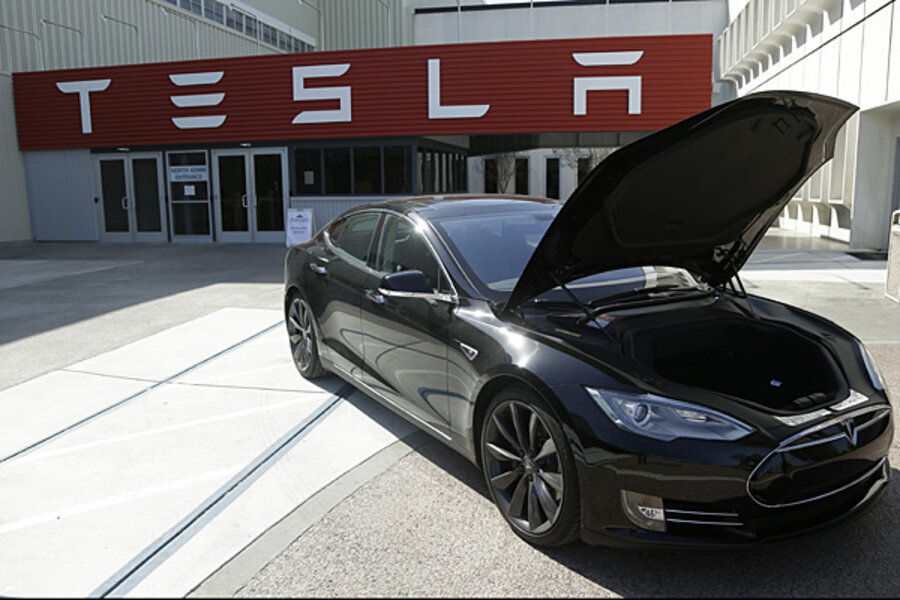Tesla repays $465 million loan. Will Energy Department lend to more firms?
Loading...
The Tesla $465 million loan may be a thing of the past, but the future of the controversial federal program that funded it is back in the spotlight.
Given the success of Tesla, will new Energy Secretary Ernest Moniz use the program's remaining funds to help other private companies? Or have the high-profile failures of other federally backed clean-energy ventures dampened the administration's enthusiasm for direct investments in the private sector?
By paying back its hefty federal loan nine years ahead of schedule, electric carmaker Tesla Motors certainly scores points for the Department of Energy (DOE). Tesla's string of recent highs has helped silence critics who pointed to the hundreds of millions of taxpayer dollars lost to Solyndra and other bankrupt companies. And the department's Loan Program Office points to a variety of quieter successes.
To date, the program's losses account for about 2 percent of the $34 billion loan portfolio, according to the Energy Department. That's less than 10 percent of the $10 billion Congress set aside to cover expected losses.
The news is well-timed for an agency turning over a new leaf. Just two days ago, Mr. Moniz was sworn in as the 13th secretary of the Department of Energy. The nuclear physicist has dropped few hints about what role the Loan Program Office will play during his tenure, but he praised the program in response to Tesla's repayment.
“The Department first offered loans to Tesla and other auto manufacturers in June 2009, when car companies couldn’t get other financing and many people questioned whether the industry would survive," Moniz said in a statement. "Today, Tesla employs more than 3,000 American workers and is living proof of the power of American innovation. This is another important contribution to what the Obama Administration has done to preserve and promote America’s auto industry."
That's not how everybody sees it. During his 2012 presidential campaign, former Massachusetts Gov. Mitt Romney routinely singled out the clean-energy loan program as bad policy. In one presidential debate, he lumped the carmaker in with federally-funded companies gone bankrupt, calling them 'losers.' Former Alaska Gov. Sarah Palin echoed the sentiment in a Facebook post last month.
Loan recipients like Solyndra and struggling carmaker Fisker Automotive could qualify as a waste of taxpayer money. But Tesla is a different story. The company's electric Model S won the coveted 2013 Motor Trend Car of the Year and received a near-perfect score from Consumer Reports earlier this month. It reported its first profit in the first quarter of the year.
Tesla Motors' stock has surged on the string of good news. Last week the company raised about $1 billion by issuing additional shares. It used a portion of that to pay back the remaining $451.8 million of its original $465 million loan from the federal government's Advanced Technology Vehicle Manufacturing (ATVM) program, first signed into law by President George W. Bush in 2008.
It is the first US automaker to completely pay off its federal loan. Ford, Fisker, Nissan, and Vehicle Production Group, have yet to pay back their loans in full.
“I would like to thank the Department of Energy and the members of Congress and their staffs that worked hard to create the ATVM program, and particularly the American taxpayer from whom these funds originate,” said Elon Musk, Tesla's chief executive. “I hope we did you proud.”
Even in success, the program has its critics. They take issue with the broader policy stance of government investing tax dollars in private companies. That role, critics say, should be left to private investors while government limits itself to funding basic research.
"There are companies that would, and often do, receive investment from the private sector because their technology is profitable or because investors find their technology promising and want to pursue the risk," Nicolas Loris, an energy-policy analyst for the conservative Heritage Foundation, wrote last month in prepared testimony for a US House Oversight Committee meeting on Fisker. "In these cases, the DOE’s loan partially offsets private-sector investments that would have been made without the federal backing."








